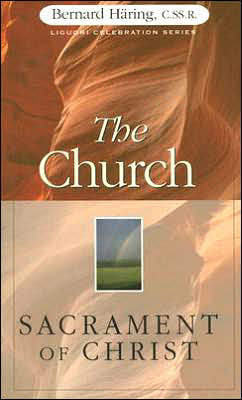
|
Posted January 25, 2008
Book: The Church: Sacrament of Christ Author: Bernard Haring, C.SS.R. Liguori Celebrations Series. Liguori. MO. 1999. Pp. 80 An Excerpt from the Jacket:
Connecting sacramental Church worship to our everyday lives as Christians, Bernard Haring poetically weaves Scripture, reflection, and prayer into a tapestry of faith renewal. Haring stresses that Christ offers his redemptive presence in the Church so that all Christians may follow his model of sacrifice through the privileged signs of grace, faith, hope, and adoration. With clarity and insight, Haring points out how the Church is, essentially, an extension of the open arms of Christ on the Cross. Only through faith in God’s Word do we understand this expression of God’s gift in Christ. If you are looking to deepen your understanding of Jesus’ life and ministry, and incorporate his timeless message of faith into your personal and Church life, this work is a helpful reference and a guiding light. An Excerpt from the Book: Healing the Healers My Confession of Faith (in the Church of the new millennium) Jesus is no stranger to admonitions, nor is the apostle Paul, but the purpose of these admonitions is entirely to point people toward their goals. The crowning goal of the Sermon on the Mount comes at the conclusion of the fifth chapter of Matthew. It is provided by the unique command to love our enemies in healing mercy. The goodness of the followers of Christ should know no boundaries, just as the Father’s mercy is boundless. In this perspective, any harsh moralism becomes simply inconceivable. But norms that lay down boundaries without continually harping on their being binding “without exception,” when put forward reasonably, will then be accepted and understood gratefully. We see before us a great company of zealous priests who are wearing themselves out – physically, psychically, spiritually – in continuous activity for their flock. Their activities increase under pressure from a society in which quantitative achievement is especially honored. There are, too, a great many unsatisfied, even frustrated, priests whose example discourage priestly vocations. Many are wounded so deeply because they do not grasp the true identity of their vocation and are unable to discern the signs of the times. Some have received a lopsided formation, marked by legalism in moral theology, formalism in liturgy, and a static view of Church. How can they feel at home in a Church which understands itself as pilgrim Church? There are also priests who gladly accept the Vatican II interpretation of Church, but are unable to find an interpretation of ministerial priesthood corresponding to it. In their confusion, many find it difficult to accept the co-responsibility and cooperation of lay people. In all of us, there is hidden “atheist” that wounds and threatens. Activists want no one to contradict them, no one to refuse the kind of dependence they wish to impose. They don’t realize that they themselves need to be grateful recipients: they need affirmation, encouragement, and correction in order to remain whole and healthy. Table of Contents: 1. Sacrament of love Mission of the Church The healing authority The authority of revelation Moral synthesis and balance 2. A wounded Church Suffering servants Wounded healers Lifestyles Healing the healers 3. Communion in the Holy Spirt Collegial Unity Spiritual freedom Formation and reconciliation Ultimate meaning |
|
